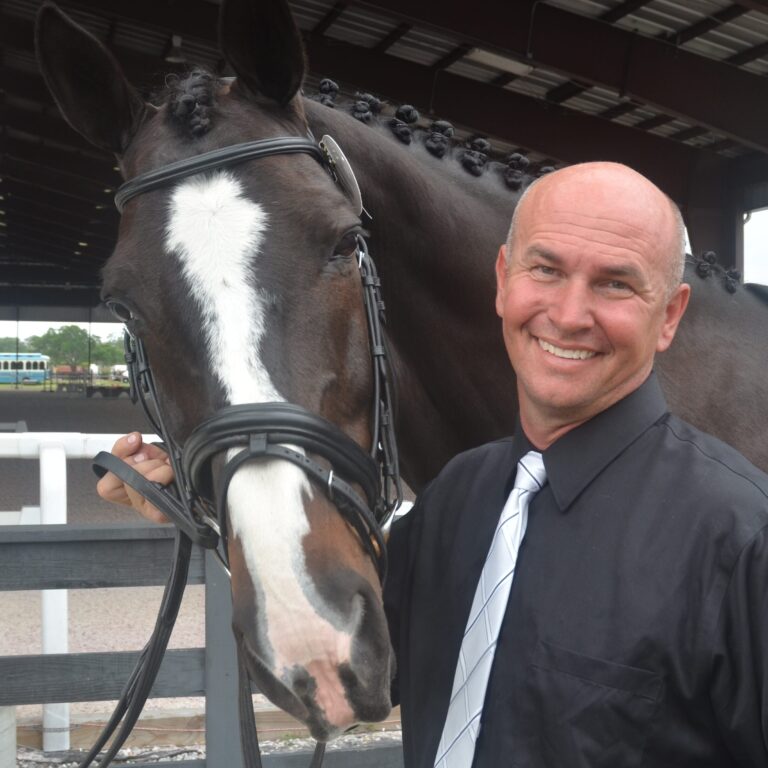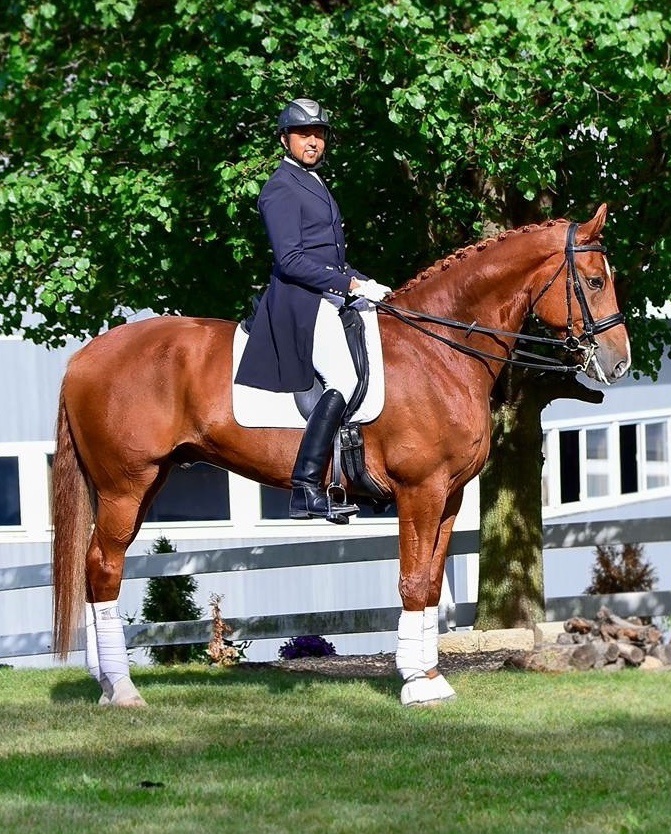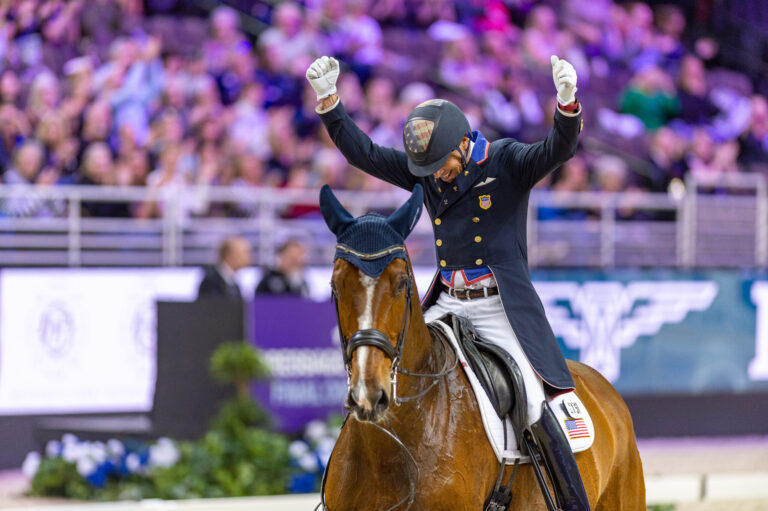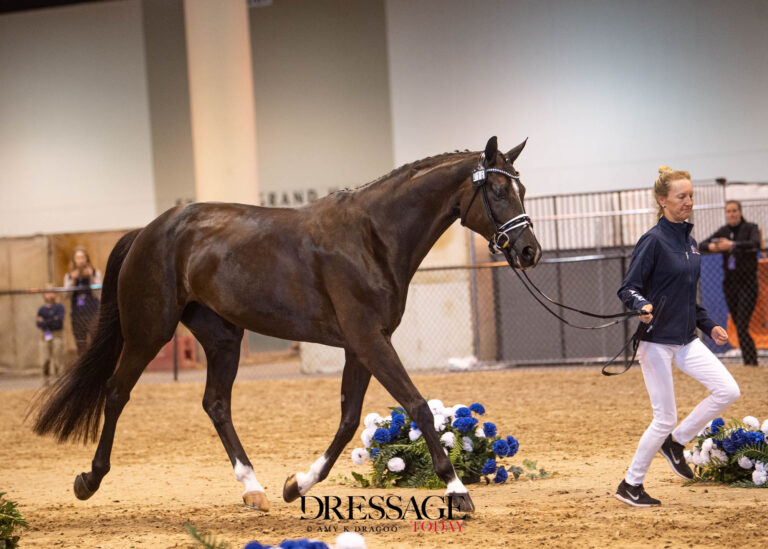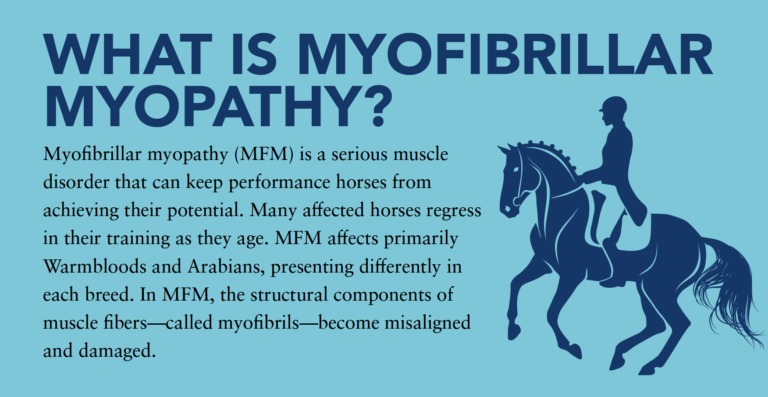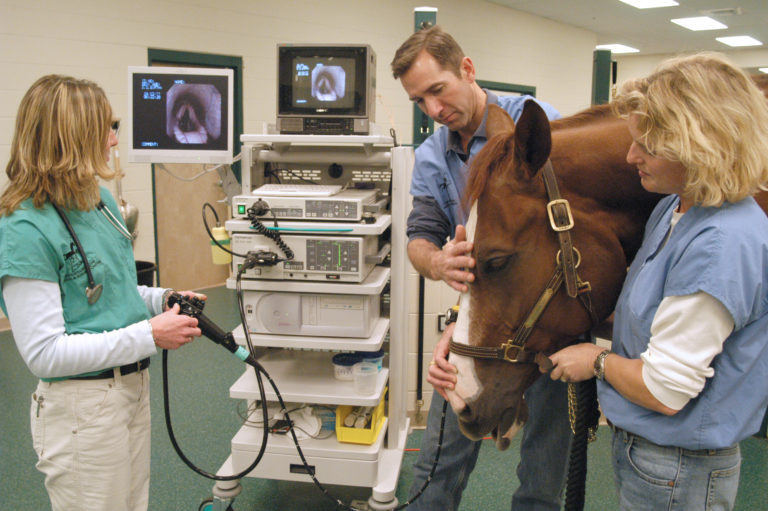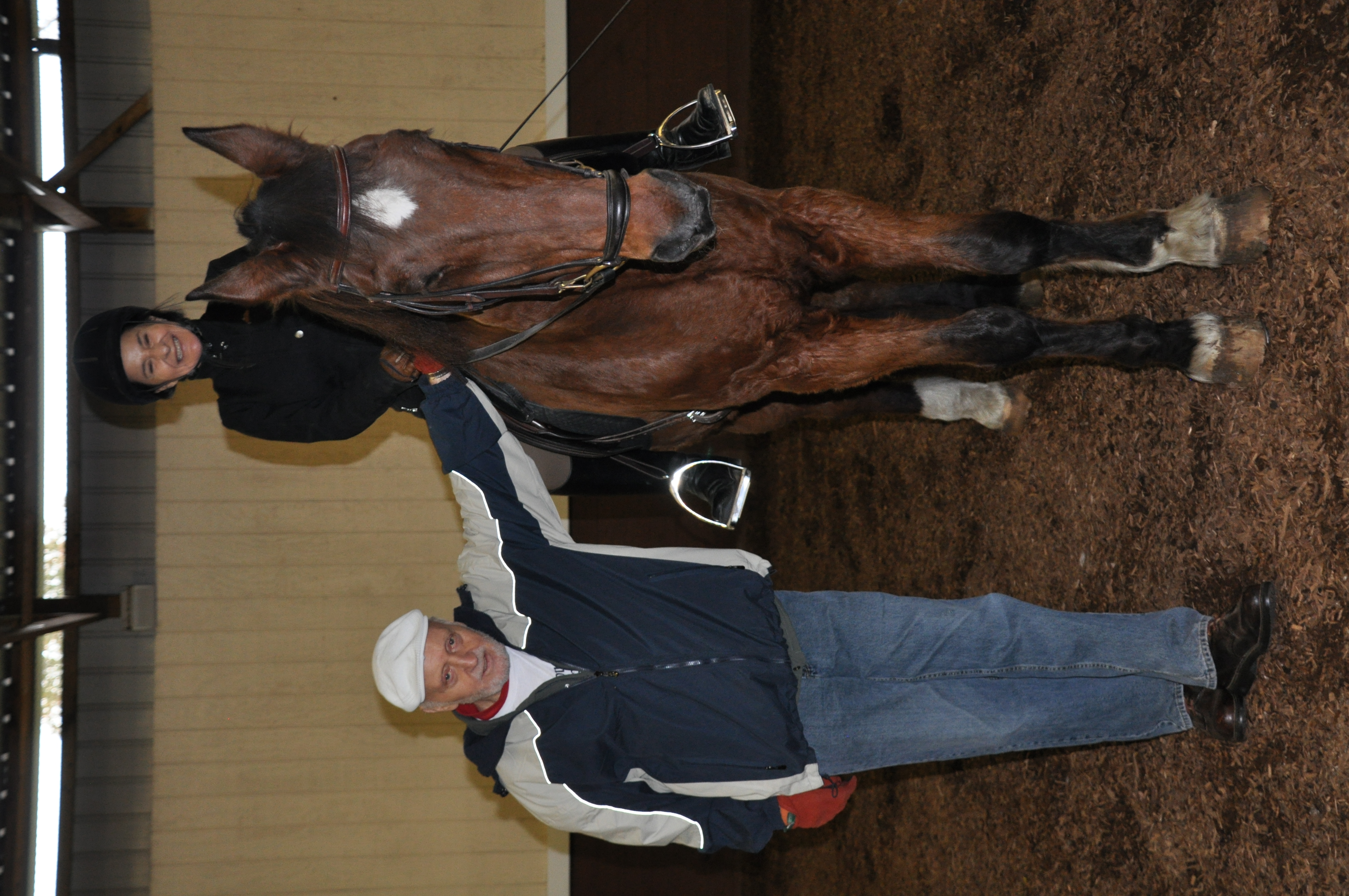
Kill #031 was more fortunate than many other horses at the New Holland livestock auction in Pennsylvania when Valerie (“Val”) Pringle of the Equine Protection Department of Human Society of the United States fell under his spell in 2013. Kill #031, later named Braveheart, was given the opportunity to learn to glide through classical dressage training with help from a former chief rider of the Spanish Riding School. Thrown away and evaluated as useless at 24, the Clydesdale/Thoroughbred-cross later proved how commitment to knowledge-based dressage training can reveal a gem of a horse and save a life.
The Livestock Auction
Val’s boss had asked her to go to New Holland to observe an auction that sells horses to kill buyers. There, she met with Kelly Smith from Omega Horse Rescue in Airville, Pennsylvania. Kelly frequented auctions and would explain the process. “The only way I could handle attending was to save a horse who could be adopted out by Omega,” Val shared. “Both healthy and neglected horses stood like farm equipment: disposable.” Her eyes locked with a handsome, 18-hand draft cross, marked with slaughter tag #031. “He had such sweetness about him. He was the one. I told him his life would be saved that day.”
Kelly and Val lost the bid to a kill buyer. “I offered an additional $50 to the buyer. He agreed. I led #031 to Kelly’s trailer and told her that his name would be Braveheart and that day, he was walking to freedom.”
In early spring 2014, after losing her own horse, Val adopted Braveheart, nicknamed “Bert” from Omega. She brought him to a riding clinic to be evaluated. “After watching me lead the horse, the clinician advised me not to ride him,” Val explained. “She said he was not sound – that he might have Navicular Syndrome. In her opinion, Bert should have been euthanized. No hope. No chance. Disposable.”
A vet later assessed the horse and said Bert didn’t have Navicular Syndrome, but might have ringbone. The horse was pasture sound but riding him was discouraged. “I was relieved that Bert would not need to be put down, but I was sad I would never ride him. I wanted to do what was best for him. My friend, CB, owns 72 acres and a dressage training facility in the rolling hills of Tennessee. She told me Bert could retire with her. I could visit. Retirement seemed the best I could give my kind and patient rescue.”
Therapeutic Dressage Training
By luck, Karl Mikolka, a former chief rider of the Spanish Riding School, had flown in to teach a three day dressage clinic hosted by CB. Karl is internationally respected as one of the finest dressage clinicians working today.
CB describes first meeting Bert: “His right leg sort of stuck out at a right angle from the hock when he walked. Karl looked him over. He commented on his kind eye and watched him walk. Karl thought something could be done through systematic training to improve Bert’s level of comfort. We were all committed to try to help Bert.”
CB got a go-ahead from her vet. Then, the farrier made special front shoes from straight bar stock. The shoes supported Bert’s underslung heels and put pressure on his frog, while supporting the sidewalls. “In two weeks, I could see an improvement in the way he stood and in the straightness of his line of travel. His improved foot fall took pressure off his joints,” CB explained.
Karl helped CB devise a conditioning program for Bert. “We began by walking a mile each direction in the dressage arena for the first weeks, five days a week. Not just slopping around, Bert walked the routine at a steady tempo, attempting to develop three strides of the inner hind leg every five meters,” CB said. CB made sure that Bert made clean corners. “We rode one stride in, three strides through the corner and one stride out. Along with a steady count, he had to maintain a steady forward traveling speed.” When Bert was crooked, they straightened him. They made sure that he was carrying his weight equally on all four legs.
This method helped build balance in Bert’s legs. His stiff right leg began to correct. They then introduced the correct three count stop, requiring him to stop on the leg of choice in three strides. Again, this developed that equal weight-carrying ability, responsiveness at the halt and to move forward from the leg of choice. In a month, the troubled right leg started to come into a straight line. Bert still had trouble picking it up to have his foot cleaned, but every time he picked it up and held it, CB gave him a treat. By month’s end, he picked it up willingly and she could easily clean his feet.
Bert advanced to an alternating walk/trot routine at month two. CB shares that the trot sequence began by asking for the depart from a particular leg, doing both the upward transition and the downward transition in three counts. This is typical of Karl’s system of teaching a horse not only to be responsive, but also to ensure that the horse is never surprised or jumped into a gait while unbalanced or in between strides.
Per CB: “Bert started by trotting 20 meters, then walking, building to 40 meters before walking, then to 60 meters and then finally to an entire trip around the 20-by-40 meter dressage arena.” This was performed in both directions. The aim was to help Bert carry his weight equally on all four legs. After a month, he had built up to a mile trot in each direction before actually beginning the day’s lesson.
As Bert got stronger, he began to work on horizontal balance in combination with vertical balance. CB introduced Bert to Karl’s signature moving turn-on-the-forehand exercise. “We required an even cross-over of both front and hind legs while maintaining straightness through the body. This became the “baby box” exercise: three steps sideways to halt, three steps forward and absolutely straight to halt, three steps sideways back the way he came, then forward, walk, transition to trot.”
Five months into the training program, Bert never took a lame step or received drugs or injections. He moved freely for a horse of his size and age. He developed considerable stamina. He was willing and looked to enjoy challenges. His rider tired before he did.
Bert progressed to exercises that involved changing the posting diagonal for a series of 10 counts/strides, riding them in decreasing counts on alternating hind legs, then riding the counts back until 10 was reached again. The aim was to improve Bert’s ability to carry weight evenly on the hind legs. He used both the outer hind and the inner hind equally, rather than letting the inner hind work harder while the outside hind drags behind as is seen so frequently in many horses. Bert showed steady improvement in the quality of his trot. The flexion of his hocks improved as well.
Bert made his under-saddle debut at a clinic a year later when Karl returned to teach several days of clinic rides. Val traveled out to see Bert and noted that that he worked a full hour with no breaks and no special treatment. “This was the ‘old, reject, slaughter-bound horse,” she added. Karl pronounced that he was satisfied with Bert’s progress and left CB with a new work plan for the next six months.
Bert eventually progressed to performing clean flying changes at the centerline of a serpentine pattern. According to CB: “He cantered accurate 20-meter circles and performed walk pirouettes. He thrived on the half-school exercise and his halts were always square and balanced. From the front, it appeared that he had only two legs. His tempo was steady. “Steady,” Karl said, approvingly, “just like a clock.”
According to CB, Bert trained five days a week and had nine hours of turnout each day. He participated in Karl’s bi-annual clinics at her farm through 2017. He thrived with only good shoeing, good nutrition, a little Previcox and Karl Mikolka’s system. Bert was willing and eager on the day before he died at 30 years old in early 2018.
Lessons from Bert’s Journey
Val and CB believe that detailed, consistent and disciplined training healed Bert, a horse who was once considered to be disposable. “Karl says that the rule in the Spanish Riding School was that all horses, regardless of talent, must be trained,” CB said. “Trained” means to become what used to be called the “campaign,” horse—a good, generous, balanced and dependable riding horse, a horse who could execute three gaits wherever they were required with absolute dependability, a horse who stands like a soldier to mount and dismount and will stand in absolute stillness until asked to move on, a horse who is light in the bridle, responsive to the whip and doesn’t have to be urged to move forward at every other stride. The goal is to produce a horse who can maintain a steady traveling tempo; covers the ground in a manner comfortable for the rider and efficient for the horse; consistently producing gait changes and riding patterns as requested; a horse who we can take out and enjoy without having to worry about surprise eruptions.
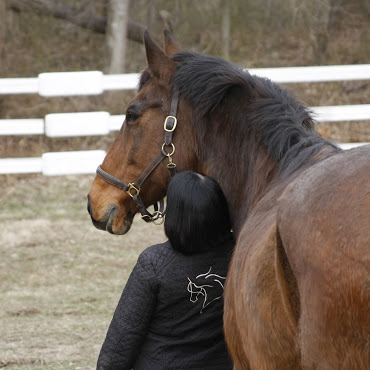
When Karl talks about the necessity of teaching a horse the basics, he means, as one example, developing a horse who is capable of executing accurate ring figures because these figures are the basis of developing balance, confidence and a sound mind in a sound body for every horse. Build a horse that people can say “What a nice horse. I wish he were mine.” That’s what Bert became. It was our honor and our responsibility to help him continue to improve until it was actually time to pass on. I think back to the gentle giant that came off the trailer. I feel exasperation with “experts” who consider a horse to be not fancy enough or not worth starting over. “Get a better horse, a showier horse.” That’s easier than working with the horse we have and helping him to be a better, happier horse and teaching us to become more proficient, understanding riders. Was Bert going to the Olympic Games? No, but neither are 95 percent of the riders and horses who attend dressage clinics and competitions. Developing a horse and rider to reach their potential together is the attainable “Olympic medal” for most of us.
Valerie and CB both believe that too many horses with potential end up at slaughter or bounced from owner to owner, because owners make decisions with a lack of acceptance of the time and patience required to create a healthy, steady, reliable horse. Dressage training can help to repair and build a horse into a sound, balanced partner. Training is a commitment to what we can achieve for the benefit of the horse. Bert, originally Kill #031, demonstrated that patient, committed, systematic training can work miracles.


